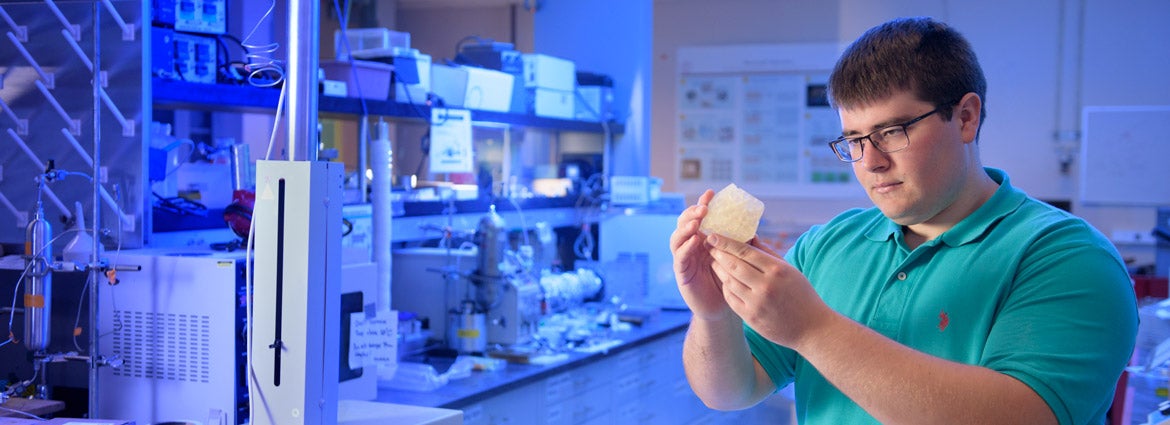Senior Tim Anderson’s research began as a joke from his faculty advisors. Now he’s a 3-D printing specialist breaking new ground in fluid dynamics.
Anderson conducts research on how fluids move underground. All sorts of fluids — oil, water, natural gas, nuclear waste — can migrate in unpredictable ways that might prove dangerous or unproductive. He doesn’t conduct his research in the field, however, but in a lab with rocks churned out of a 3-D printer.

Tim Anderson uses a 3-D printer to make perfectly identical artificial rocks. These allow for precise, repeatable lab experiments that will improve scientists’ understanding of how fluids such as oil and water move underground. (Image credit: L.A. Cicero)
It may seem counterintuitive to spend time creating your own rocks when there are many billions of them readily available outdoors, but natural rocks are all slightly different. To truly understand how liquids flow through earth, Anderson and his fellow researchers need repeatable conditions, which requires rocks that are completely alike.
We all had a laugh at the idea, but then we realized it wasn’t that bad of an idea. Then they told me to figure out how to do it.
Tim Anderson
A deep understanding of fluid dynamics is crucial for scientists and engineers who create mathematical models that can accurately predict, for example, where natural gas or drinking water might be safely stored in underground reservoirs, or in what direction plumes of toxic chemicals might migrate, or how oil drillers might minimize the risk of polluting leaks. Those crucial models are built upon real-life physical measurements from the lab or the field, and then interwoven with predictive theory.
Typically the lab tests are conducted using two-dimensional forms, but this doesn’t tell the whole picture. When Anderson was meeting with two of his faculty advisors as a fellow in the Precourt Institute for Energy’s Summer Undergraduate Program on Energy Research, Anthony Kovschek and Margot Gerritsen, they were discussing the current limitations and challenges of realistic, repeatable lab work when someone joked they should make their own rocks with a 3-D printer.
“We all had a laugh at the idea, but then we realized it wasn’t that bad of an idea,” Anderson said. “Then they told me to figure out how to do it.”
To replicate identical rock twins many times over, the researchers laser-scan a single rock, capturing every wrinkle and grain, then feed the data into the 3-D printer and watch as the machine spits out one perfect copy after another, sometimes reproducing rocks no bigger than a quinoa bud, others the size of a Rubik’s Cube.
“The biggest challenge was having to carve out an entirely new research area that we hadn’t dabbled in before,” Anderson said. “The project was very open-ended, and I got to figure out exactly what I wanted to do, and to identify limitations and opportunities. I’m very happy that during one of my summers at Stanford I got to work in a completely unexplored area.”
Now, Anderson and his colleagues can simulate different types of rocks and run fluids of different viscosity through them to illustrate how the fluids move in real life. The technique is useful for improving the understanding of how any fluid moves through a porous medium, and he’s particularly interested in applying the work to illustrate more efficient ways of extracting oil.